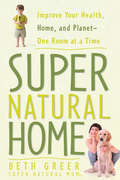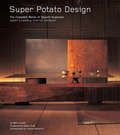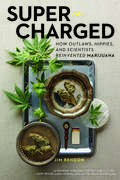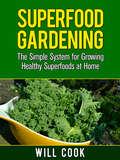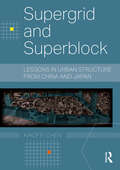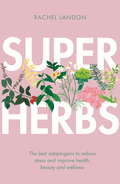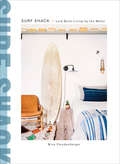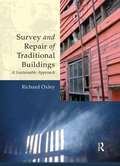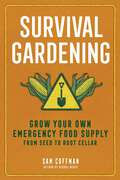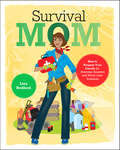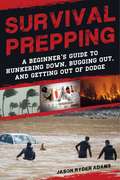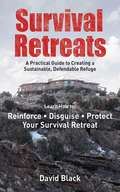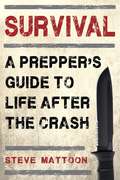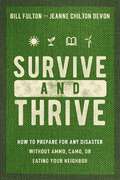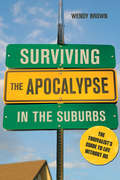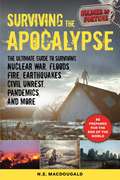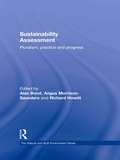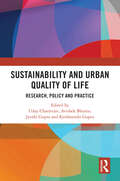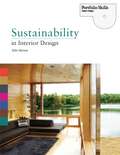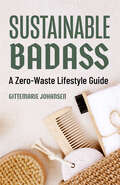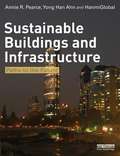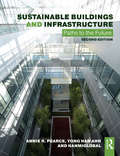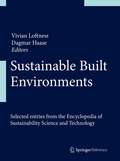- Table View
- List View
Super Natural Home: Improve Your Health, Home, and Planet--One Room at a Time
by Beth Greer“An invaluable book, filled with practical solutions on how to eat healthier, breathe cleaner air, and transform your home into a safe haven, free from toxic chemicals.”—Deepak Chopra From eliminating chemicals in your food and water to choosing clean beauty products, let the Super Natural Mom teach you everything you need to know to “live clean” in a toxic world! Beth Greer had been living what she considered a healthy lifestyle when a medical crisis prompted her to reevaluate everything—from the food she ate to the personal-care products she used and the environment she lived in. Now, in Super Natural Home, she shows the alarming extent of the dangerous chemicals we unwittingly expose ourselves to every day. As she did in her own life, she invites readers to put their lives under a microscope. The straightforward, solutions-based approach of Super Natural Home—complete with quizzes to help identify and correct potential toxic hot zones—speaks directly to what environment-conscious consumers really need: ultra-practical advice on what they can do right now to limit exposure to the poisons that are endangering them and their children. At a time when impeccable scientific research points to an alarming correlation between common chemical compounds and cancers, allergies, psychiatric disorders, and birth defects, among other serious health concerns, Super Natural Home gives consumers the tools to start protecting themselves and their families. Praise for Super Natural Home “Beth Greer’s clear, comprehensive, and practical book is a godsend for anyone living in America who wants to make a real impact on reducing the pollutions and poisons that are ubiquitous in our surroundings. She’s full of good humor, yet will help you live a far cleaner and more wholesome life than you might have thought possible. Hats off to her. Read this book.”—Peter Coyote, actor and author“Making simple changes can often have a profound impact not only on you and your family’s health but also on the planet. Beth Greer has done a fabulous job of creating a practical resource that will let you know what these changes are and how to easily implement them.”—Joseph Mercola, DO, founder of Mercola
Super Potato Design
by Mira Locher Tadao Ando Yoshio ShiratoriSuper Potato Design is the first full-length book to present the built work and conceptual ideas of the internationally renowned Japanese design firm Super Potato, founded by Takashi Sugimoto. Super Potato's powerful designs for the interiors of restaurants, shops and hotels, as well as Takashi Sugimoto's designs for tea ceremony spaces and utensils, are richly complex compositions of materials which create simple, strong spaces. By finding contemporary expression for important concepts present in traditional Japan and combining materials in unexpected ways to create exciting spaces, Super Potato's work has had a significant impact on interior design in Japan and around the world.
Super-Charged: How Outlaws, Hippies, and Scientists Reinvented Marijuana
by Jim RendonMarijuana has been illegal in the United States since 1937. Yet, thanks in large part to a loosely connected underground world of breeders, dealers, and smokers, there are currently more than 2000 varieties available. And since 1996, when California first passed legislation allowing for legalized medical marijuana, the underground has slowly surfaced, pushing what was once a decentralized, lawless world closer to the corporate world of business, agriculture, and pharmaceuticals. Super-Charged gets up close and personal with the people who have transformed this controversial drug. With personalities and backgrounds as diverse as the plant itself, the growers include a former Silicon Valley software entrepreneur; third-generation Humboldt, California, growers; a publicly traded pharmaceutical company; and the famous marijuana personality Jorge Cervantes. Jim Rendon takes readers behind the scenes and into the homes and grow operations of the committed, quality-obsessed practitioners in the international underground industry responsible for creating today's super-charged cannabis. Ironically, these pioneers who built this illegal industry may one day find themselves out of business in the face of the drug's growing mainstream acceptance. Just how this could come about is part of the incredible story.
Superfood Gardening: The Simple System for Growing Healthy Superfoods at Home
by Will CookGrow your own bountiful harvest of super-healthy, super-delicious produce with this illustrated gardening guide.Superfoods are a key ingredient for a healthy lifestyle. They are an excellent, low-calorie source of essential nutrients believed to prevent cancer and heart disease. And there’s no better way to get fresh, organic superfoods than to grow them yourself! Whether you have a tiny yard or plenty of space, starting your own superfood garden is easy with the time-tested techniques in this step-by-step guide. Urban gardening expert Will Cook explains everything from planting and fertilizing to proper watering and plant maintenance.
Supergrid and Superblock: Lessons in Urban Structure from China and Japan (Planning, History and Environment Series)
by Xiaofei ChenIn this superbly illustrated book Xiaofei Chen presents the first analysis in English of a ubiquitous East Asian urban phenomenon: the supergrid and superblock urban structure. The book opens with an introductory essay by Barrie Shelton in which he sets the scene for what is to follow, emphasizing how alien this structure was to Western urban design culture where radial patterns of development were the norm. Then, in her first chapter, Chen explains the make-up of the supergrid and superblock urban structure and its contrasting Chinese and Japanese forms. In the following three chapters she digs deep into the history, cultural origins, and underlying design philosophy of the supergrid and superblock to show how, under different cultural influences, the model has developed into two distinct forms. Two further chapters (5 and 6) provide detailed analysis of two sample superblocks in China (in Xi’an and Nanjing) and two in Japan (in Kyoto and Osaka) to reveal the relative advantages and disadvantages of how the structure is manifest in the two countries. In her conclusion she discusses her findings to show how and why the supergrid and superblock structure is a valuable urban design model which, with regional adjustments, can be used effectively in cities other than those of East Asia.
Superherbs: The best adaptogens to reduce stress and improve health, beauty and wellness
by Rachel Landon'This is the herbal guide book for modern life - with easy recipes, practical tips and pearls of wisdom - it's the perfect companion to help you use powerful herbs in a modern way.' Anabel Kindersley, co-founder of Neal's Yard RemediesTurmeric, matcha, bee pollen, ashwagandha, astragalus. Often called 'nature's miracles', superherbs, or adaptogens, help the body adapt to the stresses of life, whether emotional, environmental or immune related. We've all been informed about superfoods and the nutrients they pack, but superherbs do more than deliver vitamins and nutrition - they help to improve overall health to bring the body back to equilibrium.Featuring twenty of the most easy-to-source and use adaptogens, Superherbs will teach you the history of these ancient herbs, how each can help us in mind, body, beauty and spirit, and ten ways that we can incorporate them into our lives including recipes, teas, tonics, and DIY beauty regimes. Superherbs will help you find the best ways to de-stress, relieve anxiety, reduce inflammation and so much more, all in a healthy, natural way.
Surf Shack: Laid-Back Living by the Water
by Brittany Ambridge Heather Summerville Nina FreudenbergerFor those who combed through Cabin Porn for inspiration and The New Bohemians for authenticity, here are bungalows, trailers, cabins, and beach homes where surfers retreat after a day on the waves. Peek inside the homes of longtime enthusiasts and dedicated newcomers that reflect not just a sport or passion, but also a way of life. Blake and Heather Mycoskie of TOMS, hotelier Sean MacPherson, Gypset author Julia Chaplin, and others have set up their spaces to embrace a casual ease and be the break between the waves. With vibrant photographs of design details and bright beaches—from Malibu to the Rockaways, from Japan to Australia—this book captures the soulful milieu of a lifestyle we all aspire to."Surfers are a breed onto themselves and their homes . . . Nina Freudenberger has taken a good look at not only a number of these vastly different abodes but also a quick glimpse into the particular and even peculiar lives that are lived there. Because after all, to a surfer at least, surfing is the only life." –Gerry Lopez, renowned surfer, innovator, and author of Surf is Where You Find It
Surveillance and Surveillance Detection: A CIA Insider's Guide
by John KiriakouHave you ever thought you were being followed or watched? Have you ever needed to follow or observe someone and not be seen?In the world of espionage, surveillance and surveillance detection are a way of life. It is the job of every CIA operations officer to make sure he or she is not under surveillance—that is, being followed to the commission of an &“operational act.&” It is also the job of every CIA operations officer to surveil his own targets, whether they are terrorists or terrorist suspects, foreign intelligence officers, hostile actors, or even sometimes his own agents for vetting purposes. In everyday life, many people from all walks of life need to know how to perform similar operations. Whether avoiding a stalker, checking up on an unfaithful partner, or just securing one&’s own privacy, a working knowledge of modern surveillance and surveillance detection techniques is a critical skill to possess. And there is nobody better to teach that skill than someone trained by the CIA.From former CIA counterterrorism officer John C. Kiriakou, Surveillance and Surveillance Detection: A CIA Insider's Guide takes you through the CIA's surveillance and surveillance detection program. It will teach you to apply CIA surveillance techniques to your own everyday life. You&’ll learn how to stay safe, to ensure your privacy, and to keep the honest people honest—the CIA way.
Survey and Repair of Traditional Buildings
by Richard OxleyUnderstanding the unique requirements of traditional buildings is crucial to providing appropriate guidance on their care and repair. This book will help practitioners identify the particular issues relating to older buildings and the problems they may encounter when surveying and repairing them. With the use of examples, the author provides invaluable information on how traditional buildings perform, emphasizing the need for a sensitive and sustainable approach which also takes account of the specific needs of the building. The book examines all aspects to be included in any assessment for survey and repair, and points out in detail the potential pitfalls. It also explores the controversial issues surrounding the treatment of damp and timber decay, advocating solutions that are appropriate to older buildings rather than using standard, often damaging, methods of treatment. The extensive case studies not only illustrate good conservation in practice but also how projects can go badly wrong, and how mistakes could have been avoided. This title explores the causes of movement and the actions required. It advises on alternatives to chemical treatment for damp and timber decay. It provides fully illustrated case studies with numerous photographs. It emphasizes a sustainable approach to conservation. It outlines the key legislation issues. It includes the Historic Buildings Prosecution Fines Database and other useful appendices.
Survival Gardening: Grow Your Own Emergency Food Supply, from Seed to Root Cellar
by Sam CoffmanLearn how to grow your own food supply and be prepared just in case of an emergency with this essential guide by a survival skills expert. Become more resilient in the face of global crises and prepare yourself for supply chain disruptions by learning to grow your own food. Author Sam Coffman shows you how to select and grow the most valuable crops in the least amount of space, using few or no store-bought amendments. He also shows you how to grow food quickly (in as little as five days) in an emergency situation, choose and plant perennial food plants for longer-term harvest, grow mushrooms, forage from the backyard, and store food for the long term.
Survival Mom: How to Prepare Your Family for Everyday Disasters and Worst-Case Scenarios
by Lisa BedfordFrom the creator of TheSurvivalMom.com comes this first-of-its-kind guidebook for all the “prepper” moms keen to increase their family's level of preparedness for emergencies and crises of all shapes and sizes. Publisher’s Weekly calls Lisa Bedford’s Survival Mom an “impressively comprehensive manual,” saying, “suburban mom Bedford helps readers learn about, prepare for, and respond to all manner of disasters. . . . From 'Instant Survival Tip' sidebars to a list of 'Lessons from the Great Depression'. . . Bedford's matter-of-fact yet supportive tone will keep the willies at bay.”
Survival Prepping: A Guide to Hunkering Down, Bugging Out, and Getting Out of Dodge
by Jason Ryder AdamsFood, Water, First Aid, and Self-Defense Tips for Surviving Natural Disasters, Extreme Weather, Pandemics, Biological Threats, Terrorist Attacks, and Riots It could be a fire, flood, hurricane, tornado, or hailstorm. Financial system collapse or bioterrorism. Governmental shutdown or societal breakdown. The world is full of possible threats, and they seem to be coming at us from all sides these days. Jason Ryder Adams covers everything you need to know prepare your home, keep your family safe, and get ready to leave if the worst happens. You’ll learn how to: Prep with children and pets (and do test runs ahead of time)Plan for staying put, sealing yourself in, and leaving depending on the threatChoose and protect a safe location and develop an escape routeDefend your family with self-defense training and firearmsPut together a 72-hour emergency kit, bug-out bag, and first aid kit So don’t panic—prepare! Prepping today is for everyone. Survival Prepping is written for ordinary folks who want to get started on preparing for the worst. Adams shares bug-out plans for every scenario, safety tips, and invaluable checklists for acquiring the right supplies for emergency situations. Survival Prepping will help you ensure your family survives—and hopefully thrives—should a disaster strike.
Survival Retreats: A Prepper's Guide to Creating a Sustainable, Defendable Refuge
by James C. Jones Dave BlackNormally, retreats are built to blend in to their surroundings for the sake of secrecy, and are built by those who don’t want others to know anything about their retreat. Dave Black explores these places and gets to go where most people never go—through the chain link fence, past the guard dog, and into the rarely seen survival retreat. Not only will you learn how to protect them, but you will learn how and where to build them, and most importantly, what to do after you’ve fortified. There’s a lot to know and with this book you’ll be prepared for the inevitable apocalypse . . .
Survival: A Prepper?s Guide to Life after the Crash
by Steve MattoonDefend what’s yours when catastrophe strikes with expert tips that go beyond food and water storage.Should a national disaster occur, how will you respond? What will occur when critical societal services cease to function? As a prepper, you will likely be ready to hole up and live off of your stored supplies, at least for a while. But what do you do during that time? What are your next steps? And how do you defend yourself against others who have not prepared for such a disaster?After the Crash covers all the situations that you may face when the lack of governmental infrastructure leads to social upheaval and chaos. Since most of the population is unprepared for a disaster of any kind, this book gives both the trained and untrained prepper valuable information needed to have any chance of survival in a world where organized government assistance may not be available. Importantly, he details the crucial steps you need to take in addition to doing everything other survival manuals advise. These critical tips go beyond stockpiling food, water, and weapons.Offering battle-proven advice, Steve Mattoon explores what it takes to survive alone versus in groups, each approach presenting its own advantages and challenges. Discover how best to defend yourself, what to use, and how to most effectively use the tools you have at your disposal. Whether you find yourself in a rural area or an urban jungle, Steve Mattoon’s After the Crash will prove an essential addition to any prepper’s bug-out bag.
Survive and Thrive: How to Prepare for Any Disaster Without Ammo, Camo, or Eating Your Neighbor
by Jeanne Devon Bill FultonGet ready for a refreshing and unique take on preparedness. This essential guide is for regular people who want to handle disaster situations confidently, without digging a network of underground bunkers stockpiled with weaponry.From the really loud wake-up call of the COVID-19 pandemic to the escalating climate crisis, the world is becoming increasingly unpredictable. It&’s time to buckle up—but fear not! Army vet and sustainable organic farmer Bill Fulton and Alaska adventurer and writer Jeanne Chilton Devon will demystify the whole notion of "prepping" and make it accessible and practical for everyone.In this comprehensive handbook, you'll learn essential knowledge like water sourcing and purification, long-term food storage, stocking a disaster pantry, creating a safe home, assembling evacuation bags, and ensuring your family doesn't drive each other crazy in the face of chaos. You'll also unlock cool survival hacks to save the day when the lights are out, the gas is off, the supermarket is closed, and everyone around you is hunkered down like a mountain hermit.Unlike other prepping guides, Survive and Thrive recognizes that what we need is a collaborative, sustainable, and family-friendly approach to preparedness. Say goodbye to doomsday paranoia and learn empowering information to help you live better now and have a solid plan for whatever comes tomorrow. SPOILER: That's how we all make it through the 21st century!With an upbeat attitude, detailed instructions, how-tos, checklists galore, and even historical survival recipes, city dwellers and suburbanites alike will get organized and on the path to sustainability and resilience—whatever may come!
Surviving the Apocalypse in the Suburbs
by Wendy BrownBased on the premise that we have 21 days before we lose our modern conveniences, Surviving the Apocalypse in the Suburbs is packed with practical solutions for becoming more self-reliant and transitioning to a lower energy lifestyle. From shelter to livestock to transportation to tools, this is the ultimate guide to simplifying your lifestyle while reducing your dependence on oil.
Surviving the Apocalypse: The Ultimate Guide to Surviving Nuclear War, Floods, Fire, Earthquakes, Civil Unrest, Pandemics, and More (Soldier Of Fortune Ser.)
by N. E. MacDougaldThe Apocalypse could arrive at any moment, but with Surviving the Apocalypse, you'll be well-prepared and well-trained enough to survive any disaster—even the end of the world as we know it. Being prepared for what&’s out there is important—you have to know what to do when everything falls apart. Knowing how to survive the end of the world as we know it will prepare you for anything and everything that could possibly go wrong. From packing the proper survival kit, to surviving on the battlefield, being physically fit, and coping in the event of a socio-economic collapse, Soldier of Fortune magazine, along with N. E. MacDougald, will make sure that you&’re never caught off-guard in any situation, from natural and economic disasters to pandemics and civil unrest—even nuclear war. The purpose of this book is to provide the reader with real-world, practical information that will help them to not only survive, but thrive during a period that is likely not just another downturn in the economic cycle, but according the many experts, instead the beginning of a long downward slide, and possibly the very peak in our 10,000-year experiment of civilization. While you may not plan on being in a war zone, you never know what will happen, so the best thing to always do is be prepared. Whether it's learning how to barter and haggle, how to get the proper camouflage, or how to choose the right weapon for any situation, MacDougald and Surviving the Apocalypse will give you the training and knowledge that goes into surviving any and every dangerous situation imaginable.
Sustainability Assessment: Pluralism, practice and progress (Natural and Built Environment Series)
by Alan Bond Angus Morrison-Saunders Richard HowittSustainability Assessment is an increasingly important tool for informing planning and development decisions across the globe. Required by law in some countries, strongly recommended in others, a comprehensive analysis of why Sustainability Assessment is needed and clarification of the value-laden and political nature of assessments is long overdue. Currently the writing on the subject is limited and comprises, for the most part, guidance documents and completed assessments. This book overcomes these shortcomings by simultaneously providing the knowledge, inspiration and range of assessment tools in decision-making students require to tackle Sustainability Assessment challenges nested within wide-ranging values and sustainability-grounded evidence. The collection details the current state-of-the art in relation to Sustainability Assessment theory and practice, and considers the pluralistic nature of the tool and the implications for achieving sustainable decision-making. The contributors set out the context for Sustainability Assessment and then outline some contested issues which can affect interpretations of whether the decision tool has been effective. Current practice worldwide is assessed against a consistent framework and then solutions to some of the inherent weaknesses and causes of conflict in relation to the perceived sustainability of outcomes are put forward. The book is unique in setting out state-of-the-art in terms of Sustainability Assessment practice by focusing on those countries with developing experience. It also covers emerging factors influencing effectiveness of decision-making tools and evaluates how they affect the performance of Sustainability Assessment. Written by authors among the leading university academics teaching impact assessment courses in the most acclaimed universities worldwide operating in this field, it is ideally suited for the growing numbers of courses in impact assessment education and training.
Sustainability and Urban Quality of Life: Research, Policy and Practice
by Uday Chatterjee, Avishek Bhunia, Jyothi Gupta and Krishnendu GuptaThis book conceptualizes and synthesizes worldwide research on the quality of urban life. It looks at quality of life within urban cities analysing amenities, infrastructure and assets while also bringing in the discourse around scarcity, disparity, accessibility, sustainability, equity, and well-being.Organized into four major parts, the book reflects on the interconnections between theories and practice and through a multi-disciplinary approach focuses on the aspects of urban environment and planning that makes cities inclusive, safe, resilient, smart, and sustainable. This book highlights the enormous strain on urban areas due to severe scarcity of civic systems and provides an in-depth look into urban concerns and pressing challenges from a global perspective, as well as many planning approaches to solving these problems.This book will be useful to students, researchers and teachers working in the field of urban studies, remote sensing and GIS, planning and sustainability, sustainable development, urban geography, development geography and population geography. This book would also be an invaluable companion to thought leaders, policy makers and industry and other professionals working in the field of urban planning and human development.
Sustainability in Interior Design
by Siân MoxonThe environmental impact of interior architecture and design practice is immense. This book highlights the need for designers to adapt the way they work and relearn lessons that have been lost. Contrary to many preconceptions, sustainable design can be sophisticated and stylish. And by its nature, a sustainable approach means considering the whole life cycle of a project and therefore improving the functionality, quality, human enjoyment and, in the long term, bringing real social and economic benefits. This book has examples, techniques, and historical and contemporary case studies, all supported by useful resources and links. A comprehensive reference book for anyone wanting to work in this area, Siân Moxon aims to introduce the ideas behind sustainability to design students while they are formulating their understanding of the industry, encouraging and inspiring them with positive, creative and practical alternatives.
Sustainability in Interior Design (Portfolio Skills)
by Siân Moxon Sian MoxonThe environmental impact of interior architecture and design practice is immense. This book highlights the need for designers to adapt the way they work and relearn lessons that have been lost. Contrary to many preconceptions, sustainable design can be sophisticated and stylish. And by its nature, a sustainable approach means considering the whole life cycle of a project and therefore improving the functionality, quality, human enjoyment and, in the long term, bringing real social and economic benefits. This book has examples, techniques, and historical and contemporary case studies, all supported by useful resources and links. A comprehensive reference book for anyone wanting to work in this area, Siân Moxon aims to introduce the ideas behind sustainability to design students while they are formulating their understanding of the industry, encouraging and inspiring them with positive, creative and practical alternatives.
Sustainable Badass: A Zero-Waste Lifestyle Guide
by Gittemarie JohansenA Guide to Being Sustainable at Home and in Life“Gittemarie is creator that not only provides helpful tips on living a zero-waste and vegan lifestyle, but also articulates it in way that is approachable.” —Jhánneu Roberts (@Jhanneu)#1 New Release in Upcycling & RepurposingReshape your conventional habits, purchases, and recipes with these simple yet effective zero-waste alternatives!Eco-friendly living made simple. As a lifestyle guide and an introduction to sustainable living, Sustainable Badass shows you why and how to minimize your consumption while effortlessly making your habits greener. Each page has practical tips, tools and important facts about plastic pollution, overconsumption, and the climate crisis. From small changes such as pre-cycling and purchasing items with minimum to no packaging, to eliminating plastic entirely; this book empowers you to be a sustainable badass by making effortless planet-positive choices in your everyday life.Know the cause, be the change. Gittemarie Johansen, sustainability blogger and speaker, teaches you the way to a greener, more simple and happier life by implementing self sustainable living principles, all while putting the power into your hands as the consumer to speak up and demand change for our planet.Be sustainable at home.Sustainable Badass encourages you with some effortless principles on the best sustainable home goods. Enjoy this holistic and accessible approach to creating a self sustainable home and lifestyle, that is easy to implement, and fundamental to saving our planet.Inside, you’ll find:A guide to being intentionally sustainable at home Effortless and intentional steps to withdraw from consumerismAll the knowledge you need to live a sustainable life at home and with othersIf you liked Simply Living Well, Live Green, or Attainable Sustainable, you’ll love Sustainable Badass.
Sustainable Buildings and Infrastructure: Paths to the Future
by Annie Pearce Ltd Hanmiglobal Co Yong Han AhnConstruction is one of the biggest industries in the world, providing necessary facilities for human prosperity ranging from the homes in which we live to the highways we drive, the power plants that provide energy for our daily activities, and the very infrastructure on which human society is built. The construction sector, including the building sector, has among the largest potential of any industry to contribute to the reduction of greenhouse gas emissions. This ambitious and comprehensive textbook covers the concept of embedding sustainability across all construction activities. It is aimed at students taking courses in construction management and the built environment. Written in a lively and engaging style the book sets out the practical requirements of making the transition to a sustainable construction industry by 2020. Case studies are included throughout making the book both a core reference and a practical guide.
Sustainable Buildings and Infrastructure: Paths to the Future (Hakluyt Society, Second Ser. #15)
by Yong Han Ahn Annie R. Pearce HanmiGlobal Co, LtdThe second edition of Sustainable Buildings and Infrastructure continues to provide students with an introduction to the principles and practices of sustainability as they apply to the construction sector, including both buildings and infrastructure systems. As a textbook, it is aimed at students taking courses in construction management and the built environment, but it is also designed to be a useful reference for practitioners involved in implementing sustainability in their projects or firms. Case studies, best practices and highlights of cutting edge research are included throughout, making the book both a core reference and a practical guide.
Sustainable Built Environments
by Vivian Loftness Dagmar HaaseSustainable design is a collective process whereby the built environment achieves unprecedented levels of ecological balance through new and retrofit construction, with the goal of long-term viability and humanization of architecture. Focusing on the environmental context, sustainable design merges the natural, minimum resource conditioning solutions of the past (daylight, solar heat, and natural ventilation) with the innovative technologies of the present. The desired result is an integrated "intelligent" system that supports individual control with expert negotiation for resource consciousness. International experts in the field address the fundamental questions of sustainable design and landscape management: How should the sustainability of landscapes and buildings be evaluated? Which targets have to be set and which thresholds should not be exceeded? What forms of planning and governance structures exist and to what extent do they further the goals of sustainability? Gathering 30 peer-reviewed entries from the Encyclopedia of Sustainability Science and Technology, Sustainable Built Environments provides comprehensive, multidisciplinary coverage of these issues and other aspects of sustainable building and landscape design.
